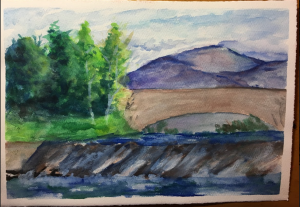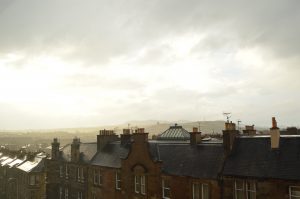I traverse the path from the Kenarden Hall towards Beall Avenue daily, diagonally lumbering between Ebert Hall and the Arch. The trees cultivated here are always beautiful, but today they strike me differently. The first one I notice is northwest of where I stand, a relatively young Ginkgo biloba. Its little fans are green at their stems, a delicate chartreuse, and radiate out into brilliant yellow, making the branches look as if they are glowing. The next to catch my eye is a Japanese maple outside of Ebert, to my northeast. It is so red I would not be surprised if it had erupted from an enormous wound, bleeding leaves all over campus. To the south I can peek through the arch to see red and green static, the blurry leaves of trees farther away in the academic quad. I swing my gaze back towards the west to see the magnolia tree, which looks like it has only been dipped in decay, with its top branches extending into large brown ovals, and below those yellow, and down, closer to me, as brilliant green as if the seasons had not yet changed.
Asides
Tuscany Landscape
Here, the city of Florence is all encompassing, cobblestone roads and terracotta buildings stretching along narrow streets. There are only people, dogs, and pigeons here. In spite of its beauty, there are only a few oases of green. One block away is a tiny park of trampled grass and cigarette butts. But go one more block and you’ll reach a beautiful plaza with a wisteria bush just beginning to bloom. The cars circle round and round the island of nature. Off to one side is a walled in area where I have often sat and drank a morning coffee. The sounds of the street are muffled here.
Go further and you’ll find the Arno river. It is not as grey as the river of my hometown, though it is still somewhat dirty. There is a strip of concrete along the bank forming a dam where I sit and sketch. The opposite shore is bright and green. In the distance, past a weathered bridge are the mountains.

The mountains are the beauty that I seek. On bus rides I watch them wiz by, grass green fields and vineyards, cypress trees planted in neat rows. Rolling hill of flowers, stretching on and on, a picturesque landscape. Further on is the sea, bright and blue, more so than any body of water I have seen in America. It crashes against rocky shores. I walk along the edge, picking up water smoothed stones before returning them to their home.
The Storms
My flat was the living room of a cabin in the Adirondacks that we have rented for years. The cabin has nearly become a second home for my family and I. It was early morning, and I was sitting in the heated living room that had a big window overlooking a frozen lake, with mountains behind the lake. It was sunny at the time, but the forecast called for on and off snow showers all day. As the morning progressed, I looked to the west and saw the onset of dark clouds take over the shining sun. The clouds were moving fast, and before I knew it, it was dumping snow the hardest I had ever seen it. It only lasted 10 minutes before the sun came out again, but the snow had accumulated a couple inches. Specifically, I remember it did this several times throughout the day. it was a constant cycle. The sun fading away, then heavy snow, and the sun coming back out again. I had never seen the weather so bipolar. This phenomena was known as lake effect snow, in which the easterly wind that blows over Lake Ontario picks up moisture and dumps heavy snow up to a couple hundred miles inland.
Greenfield, NH
In my mind’s eye, I sit atop a hill, in the backyard of my grandparent’s farmhouse. “Backyard” probably isn’t the correct term. It’s a long rectangle of mowed grass where their dogs run, stretching from the back patio to the goat pens. My brother’s dogs run around me and the goats jaunt together through their enclosure. If I walked forward a few acres, through tall grass and damp marsh, I would hit Crotched Mountain. I can see it from here. In the damp morning light, fog gathers toward the mountain’s base. The moisture makes everything, the trees, the grass, the moss on ancient rocks, turn a startling emerald green. I walk down the powdery farm road, which twists and turns through a small portion of the land. I look in any direction and I see old stone walls, assembled by hard working farmers, fencing off their own animals in the days before you could just buy galvanized steel wire mesh. I wonder if the coyotes knew how lucky they were. If I walked long enough in any direction I would probably find one. At night, we can see their eyes. They can’t be far. If I were my brother I would bring a gun, but I have no desire to kill today. I just want to see the furry creature that would eat my baby goat in a heartbeat. I can relate. I go from petting my dear Matilda to chowing down on some kebab. I walk through the woods, eyes peeled for movement. I know I won’t find anything. The newts and water bugs are enough for me.
Edinburgh
My flat was on Ratcliffe Terrace; located in a largely residential neighborhood just south of the city center, about twenty minutes walk from the university. From our kitchen window on the fifth floor, I could see out over the rooflines of the adjacent buildings. Each featured a fine row of chimneystacks, in formation, and long out of use. With antennas raised and skylights additions built in, these homes adapted to the times. Beyond these rows of shops and apartments are the houses of Morningside and the Braid, some of which are of fine stone exteriors and others of pebbledash. Their likeness is just visible from this distance. The rest of the skyline, even further away, is formed by Blackford Hill. One of Edinburgh’s seven hills, this local nature preserve was a perfect place for walking and reflecting. If I concentrated hard enough I could make out the Royal Observatory near its summit. Finally, along the horizon towards the southwest are the Pentland hills. Extending twenty miles in length, these rolling geologic forms mark the furthest reaches of the city.

Residence Quad
I am sitting in the residence quad with Stevenson directly behind me and Ebert straight ahead. To my left is the tennis court with a green fence that is approximately seven feet tall. Many people walk parallel to the tennis court and do not look around. Some stare at their phones, others talk on their phones, and some would rather look down at the ground than up at the trees. Beyond the tennis court are trees, beautifully colored trees ranging in shades of brown, yellow, red, and green. I continue to scan to the right, and the trees fill the skyline. However, if I look a little closer to ground level, I see cars. Jeeps, minivans, sedans, you name it, the parking lot has it. It’s really quite a shame because the trees are so beautiful, but it’s hard to ignore the cars. When I look straight ahead, I see Ebert. For an art building it isn’t very pretty. There is a lot of tan brick, some red brick, and some windows on the second floor. When you look closely, you notice that the windows have dark streaks that bleed to the ground. A little to the right there are more trees with equally beautiful colors as the aforementioned. When you first gaze at the trees, there is an assortment of colors. You might believe that each tree is a solid color, but when you study each tree, you notice that it varies in color. The tops of the tall trees are red and then quickly transition to a golden color. Yet both the sides of the trees and the leaves that are located deep within their branches are green. Beyond these trees lies Kenarden, a dormitory building with pretty architecture. But if it were trees, it would be even prettier.
From the porch looking out
Down from the kitchen on the back porch is the hill to the parking lot. It rolls down a 45 degree incline to a cement curb which holds the cars in place and holds the leaves as the fall into a plaster cover of reds and yellow. The ivy leers from above me, leaking up from the north side of the house to the lattice siding. Looking past the parking lot is the thin tree line which hides the church camp behind, all I can make out is the compost bin and the plastic play area. Beyond that a line of houses which I cannot see from here, rows of houses lining the warped and weathered Burbank road. And houses and houses and houses, until finally the fields take over.
The Mysterious Purple Bush (#4)
Leading to Holden Hall, there is a sidewalk with two bushes on either side. Every day, I passed those bushes every day on my way to work and class. I particularly remember one day that I noticed them, they seemed to be reaching out to me. I had never seen them so healthy. Their purple leaves looked vibrant and intense. I was sad to see the bush die during the winter along with most of the other plants near Holden. It is always a dull time that follows the beautiful colors of fall until the first snowfall. However, the bush came back to liven up the area in the spring. I never knew that this particular bush was called a Heather plant until recently. The bush produces lots of very little flowers which gives it the appearance of being entirely purple. It covers a lot of ground, making it very large. While I do not live in Holden Hall anymore, I do take a special note of the bush every time I happen to pass by.
Pawpaws: More than just Ohio’s State Fruit
When I first discovered that a pawpaw is one of Ohio’s two state fruits, my only question was “What on earth is a pawpaw?”.
As I have come to find out, besides being a state fruit of Ohio, the pawpaw is also found in most of the Eastern United States besides New England and Florida. It looks like a tropical plant and provides a delicious fruit. The pawpaw tree grows to be around 25 feet tall and grows best in moist, rich soil. It is a member of the Annona Family and is distantly related to the Magnolia tree and Tuliptree. You can recognize the pawpaw not only by its yellow-brown large lima-bean shaped fruit but also by its dark, shiny, tropical-looking green leaves and purple-red flowers.
Upon inspection around camp (and a helpful tip from Ingrid), I found a pawpaw tree outside the front of Lowry in the little island in between the parking lot and Beall. It is really pretty and it was interesting to able to see one in person.
